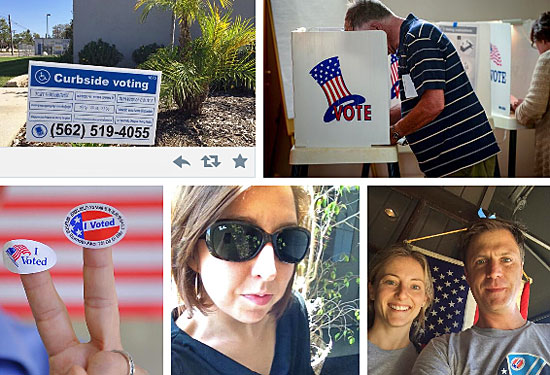Voting’s future: #FixIt
June 19, 2014

The #LAVote Twitter feed was busy on Election Day, sharing updates and photos from around the county.
After Tuesday’s primary election, Los Angeles County Registrar-Recorder/County Clerk Dean Logan noted the irony of his role the night before: He was using new technology—that is, tweeting—to explain to voters why the county can’t post instant election results on the Internet.
One of his tweets, also posted on the Registrar-Recorder/Clerk’s website : “L.A. County covers a large geographic area. It will take time for secure transport of ballots to HQ (that’s headquarters in Norwalk) for tabulations.”
During the evening, Logan and other county officials kept the Twitter generation entertained with updates and photos of bright red boxes of paper ballots security-sealed and ready for transport. Logan loves the real-time dialogue with constituents, but pleads for patience from those among the county’s 4.8 million registered voters who may blame reporting delays on county staff.
Secure transport of ballots doesn’t begin until the polls close. “Once that’s done, the counting process is fast — but we have to get them to Norwalk,” he said. (Still, as of Wednesday, thousands of “provisional” and last-minute absentee ballots remained to be counted.)
Both tired and exhilarated on Wednesday morning, Logan said it might be a long time before voters can cast their vote online or get instant election results. That’s hard to explain to a public that’s used to doing everything online, from paying bills to voting for the next American Idol.
“What it really comes down to is the value of the history of the secret ballot,” Logan said. He explained that while an online activity such as banking is a secure transaction, it still requires that the identity of the individual be linked to the account so the bank knows who you are. At the polls, the voter signs in so he or she can’t vote more than once, but once the paper ballot is placed in the box it can no longer be connected to any individual voter.
But Logan is more confident that the county can streamline the current voting process to better serve the demands of a new generation of voters in other ways. “We’re looking at modernizing the voting systems,” he said. Tuesday’s startlingly low voter turnout, he said, is one more indicator of a voting process that is “at the end of its life cycle.” (Only 13.1% of eligible county residents voted, the lowest turnout in the state.)
Last year, the county launched a massive updating of the voting apparatus to be more user-friendly, with updated equipment to be available at the polls in 2016, part of a broader effort that includes research into the future needs of an increasingly large and complex population.
And on Wednesday, the county passed an ordinance—initiated by Supervisor Zev Yaroslavsky —that will require candidates to file their campaign finance reports electronically, with the goal of eliminating the slow, labor intensive data entry process and providing quicker, more complete access to the public.
By the November 4 general election, Logan said, campaign donor information will be available online for all candidates. While optional electronic filing has existed for several years, he said, only 50% of L.A. County candidates have been filing online. Some information was only accessible on paper at Norwalk headquarters.
“And some candidates have done a hybrid, sometimes electronically, sometimes paper,” he said. “The first step is to make that an even playing field. All of the candidates will be filing in the same manner.”
He adds that it’s not enough to post campaign finance information: the county plans to make sure it’s presented in a searchable, user-friendly format. (One minor downside: Because the information will be entered online by the candidate’s campaign management, errors or violations will be publicly visible before the county has a chance to see the entry and notify the campaign of the problem.)
Logan called the move significant because “it’s one step in updating the whole process.” The goal of the county, he asserts, is “transparency, security and accountability.”
Logan said his department also is looking at new ways to bring younger voters to the polls, including the opportunity to vote at any polling place, rather than having to make it to a designated polling location during voting hours.
And the poll worker pool needs to be expanded beyond the current demographic, which skews heavily toward older people and retirees. “There is not the population available that’s willing to put in a day’s work for what is essentially a civic volunteerism act,” he said. “Some do it for the stipend, which I think is $175, but there are certainly areas of this county where that’s not an incentive.”
Logan says the department will carefully consider each update to the system. “People are now used to getting information on a real-time basis and our system isn’t designed for that,” he acknowledged. “But we need to make sure we’re not duplicating [problems] with a newer version of the old process. We need to make sure there’s value added, and a flexibility to change with the times.”
Posted 6/5/14












 405 bridge work causes a stink
405 bridge work causes a stink
